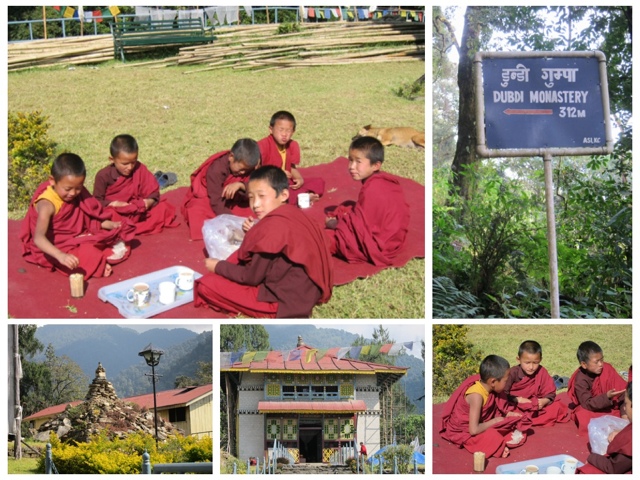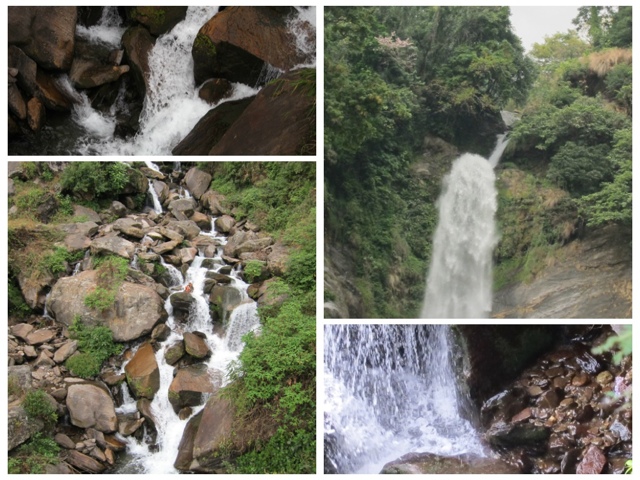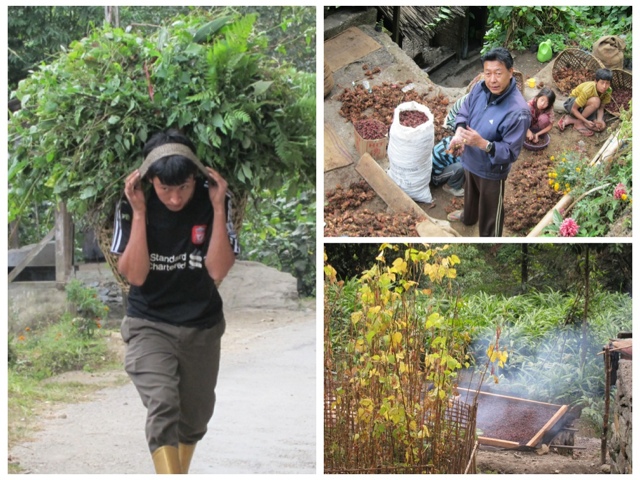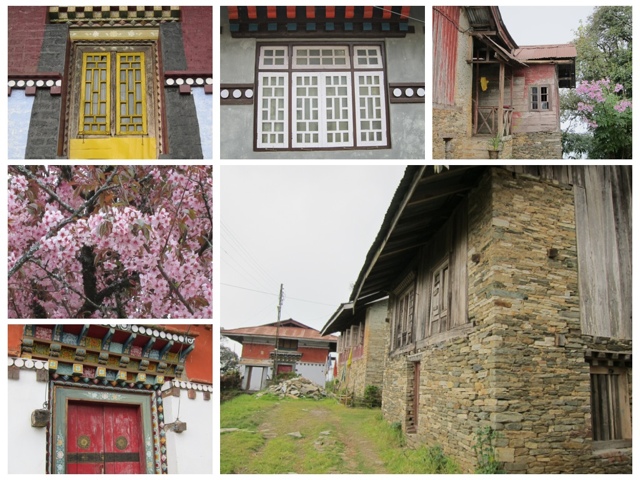From Yuksom to Pelling, and a visit to the Pamayangtse Monastery
Early in the morning, we woke up to an earthquake.
The bed and walls shook violently, and in my hazy sleep, I thought that something had fallen on the roof.
But it was an earthquake after all, and no serious damage was reported.
In the morning we walked to the Dubdi monastery.
The steep stone path passed through the forest, and moss grew between the green stones, giving the path the appearance that it was actually a long green carpet.
This small monastery is said to be the oldest Buddhist temple in Sikkim, built in the 1600's.
It suffered much damage from last year's earthquake, and a lot of the plaster fell off the walls, destroying much of the old beautiful mural paintings.
An old stone stupa that had stood next to the temple hall and had survived for hundreds of years, had collapsed as well.
The monks were doing a puja for the day the Buddha return to earth from the Tushita heaven.
Because the temple was small, we had to walk around the chanting monks to admire the wood carvings and the art.
A large group of devotees just arrived when we were ready to leave.
They brought food and offerings, and the young monks who had been waiting for them on the path, walked before them beating drums and ringing bells.
Down by the village, our driver Raju was busy washing the car by the side of the creek.
You see this kind of scene happen everywhere in Sikkim.
I call it "Spring-Side Carwash."
Drivers just pull their cars to the side of the road by a mountain spring, a waterfall, a river or a creek, and they spend a long time washing their cars, leaving the carpets to dry on the rocks and splashing water like joyful kids.
Raju seemed to know everybody in Yuksom.
Every ten minutes he stopped the car to briefly chat with people he knows.
Our guide Sudesh told me that Raju used to trek in these mountains for many years.
He used to be a Sherpa and this is how he knows everyone around town.
Raju is a success story in this area.
He went from being a Sherpa boy who carried in a head-basket (called Doko) supplies and bags up steep mountains, to becoming a successful man who owns two houses, a new taxi car, with a happy marriage and a cute little daughter.
In Yuksom we visited the ruins of the throne of the three old lamas.
Yuksom is the oldest capital of Sikkim.
We drove towards the town of Pelling on a beautiful mountain road that offered many views of different large waterfalls.
Unfortunately during the monsoon season, much of the road is washed out by those waterfalls.
We stopped by the Kanchenjanga waterfall, to admire the strong falls.
Many food and snack vendors lined the road.
We ate a potato curry with some shaved roasted rice flakes, while sitting in one of the shacks.
It was delicious.
We also had tasted some fresh popcorn and stocked up on one of the only brands of chocolate that taste good in this rural part of the world.
The shack was built on a wooden platform that was framed with a few pieces of wood and bamboo, precariously attached to some posts by the road.
The road was so narrow, that in order to do business, the vendors had to build their stalls over the river and the ravine.
The couple who run the shack we were sitting in, told us that they work the whole day every day during the season, and close for the monsoon months.
They have done this for the past fifteen years.
To supplement their income, they also own land on which they grow cardamom.
I bought some tree acorns, which were fairly tasty.
I offered the rest of them to some old village guys who came and sat by me.
They had no teeth but they were very happy to munch on those nuts.
Along the way, we visited a forest lake that is known as the "Wish Fulfilling Lake."
In Pelling we had a late lunch of South Indian Dosas and ginger tea
We continued on to the town of Gezing (Gatshaling), to our hotel, the Tashigang Resort.
Our room was a cottage suite, but the living room was freezing cold and half of it was taken up by a broken pinball machine.
The bedroom was fine after I asked them to change the unclean sheets and to bring us more pillows and a heater.
The room warmed up and felt better.
We ate our dinner in our cottage and the food was surprisingly good.
The next day our guide suggested that we check out of this hotel and move to the elegant Elgin hotel, that belongs to the Oberoi family... We happily agreed.
This area of Western Sikkim is known as the cradle of Buddhism in Sikkim.
The three Lamas who had a vision of coming to Sikkim to spread Buddhism,
installed a ruling king and thus started the Namgyal dynasty.
They searched and found Phuntsog Namgyal and anointed him with holy water, giving him the title of "Chogyal" – the king of religion, and urged him to spread Buddhism amongst the animist Lepchas.
Pamayangtse Temple was built in 1705.
The name Pamayangtse means 'The Sublime Perfect Lotus.'
It belongs to the Nyingma sect of Buddhism, and it is well known for its seven level wooden pagoda structure of stunning intricacy, depicting the Buddhist paradise and the heavenly abode of Guru Rinpoche.
The late Dongzin Rimpoche crafted this amazing Mandala shaped wooden pagoda over five years of solo effort.
The pagoda was installed on the second floor of the temple, surrounded with good new murals on the walls.
Many parts of the murals that depicted the Divine Union of male and female were covered in a fabric.
It was believed that they may be interpreted as sexual paintings.
It was sad that we were not allowed to see the paintings, and a young monk walked right by us and made sure that we would not lift the fabric and take a peek.
The Pamayangtse temple also had a great display of beautiful old clay sculptures of the eight manifestations of guru Rinpoche.
It is said that the Guru was able to take on eight different physical forms, and to appear before the people as needed.
We saw a display of old Cham festival costumes and hats, old wooden masks that were used during annual mask festivals, and a collection of antiques and ritual props.
Nearby we visited the Sangacholing Monastery.
It is known as "The Place Of Secret Spells."
It was founded in 1697.
It looked closed, but a tiny boy with a skin affliction, opened the temple door for us to look inside.
The impressive clay statues dated back to the 17th Century and were amongst the oldest in Sikkim.
The paintings on the walls were in need of restoration, as were the old stupas on the hill.
We thanked the little boy and he went back and joined his friends in playing 'Snakes and Ladders,' a board game where you roll the dice and advance up ladders or slide down on the backs of snakes, depending on whether you hit a lucky or an unlucky number.
We saw the ruins of Rabantse, the ancient capital city.
Much of the ruins were further ruined by last year's earthquake.
We met a mason who was working at renovating the ruined walls.
His told us that his father had taught him how to cut and carry stones.
He said his father and his mother were "Lit," meaning that they were dead and cremated... "Lit by a fire...."
He also told us that it will take him only a few more months to completely restore the three old stupas which had collapsed to rubble in the recent earthquake.
It seemed impossible to me that he would be able to do it so fast... With no machinery and only hand tools...
At our new hotel, the Elgin, we got a room with stunning views of the Kanchenjanga mountain range, and a picture window overlooking the lovely manicured garden.
The room was clean and had an elegant design, a soft bed (not the impossibly hard wooden platform on which most locals sleep), and the hotel offers a pleasant lobby with good tea from silvery pots.
The hotel manager and his wife, told us that they were having a lot of problems with the Pamayantse monastery, which owns the property which neighbors the hotel.
They said that the Lamas cut off their water supply, took off their sign, let their cows loose on the hotel's lawns....
They said that recently they had put up a fence to keep the cows out, but that they continued to give their lawn cuttings to feed the monastery's cows.
They told us that the monastery collects tax from all the locals, including them.
It is a mandatory tax, which they said is left over from ancient times, when the Lamas and the old Monasteries used to rule this region.
They added that they would not have minded paying this mandatory tax, if the money really went to educating the young monks, to fix the old monastery, or to help the community.
They said that the Lamas were getting rich, building expensive homes for themselves in hidden places in the mountains... Taking expensive trips oversea, and buying the newest Smart Phones or expensive cars for themselves...
So.... I guess that every time you organize a thought system, even one that preaches love and compassion for everyone, like Buddhism does, you might get some monks who do not follow the path of enlightenment with a pure desire for liberation in their hearts, but who are looking for political power and money.
All around Sikkim, there is a big difference between how the small community temples feel and run, to how the big well-funded and wealthy Buddhist temples feel and run.
Sikkim is a land of diversity indeed....
The bed and walls shook violently, and in my hazy sleep, I thought that something had fallen on the roof.
But it was an earthquake after all, and no serious damage was reported.
In the morning we walked to the Dubdi monastery.
The steep stone path passed through the forest, and moss grew between the green stones, giving the path the appearance that it was actually a long green carpet.
This small monastery is said to be the oldest Buddhist temple in Sikkim, built in the 1600's.
It suffered much damage from last year's earthquake, and a lot of the plaster fell off the walls, destroying much of the old beautiful mural paintings.
An old stone stupa that had stood next to the temple hall and had survived for hundreds of years, had collapsed as well.
The monks were doing a puja for the day the Buddha return to earth from the Tushita heaven.
Because the temple was small, we had to walk around the chanting monks to admire the wood carvings and the art.
A large group of devotees just arrived when we were ready to leave.
They brought food and offerings, and the young monks who had been waiting for them on the path, walked before them beating drums and ringing bells.
Down by the village, our driver Raju was busy washing the car by the side of the creek.
You see this kind of scene happen everywhere in Sikkim.
I call it "Spring-Side Carwash."
Drivers just pull their cars to the side of the road by a mountain spring, a waterfall, a river or a creek, and they spend a long time washing their cars, leaving the carpets to dry on the rocks and splashing water like joyful kids.
Raju seemed to know everybody in Yuksom.
Every ten minutes he stopped the car to briefly chat with people he knows.
Our guide Sudesh told me that Raju used to trek in these mountains for many years.
He used to be a Sherpa and this is how he knows everyone around town.
Raju is a success story in this area.
He went from being a Sherpa boy who carried in a head-basket (called Doko) supplies and bags up steep mountains, to becoming a successful man who owns two houses, a new taxi car, with a happy marriage and a cute little daughter.
In Yuksom we visited the ruins of the throne of the three old lamas.
Yuksom is the oldest capital of Sikkim.
We drove towards the town of Pelling on a beautiful mountain road that offered many views of different large waterfalls.
Unfortunately during the monsoon season, much of the road is washed out by those waterfalls.
We stopped by the Kanchenjanga waterfall, to admire the strong falls.
Many food and snack vendors lined the road.
We ate a potato curry with some shaved roasted rice flakes, while sitting in one of the shacks.
It was delicious.
We also had tasted some fresh popcorn and stocked up on one of the only brands of chocolate that taste good in this rural part of the world.
The shack was built on a wooden platform that was framed with a few pieces of wood and bamboo, precariously attached to some posts by the road.
The road was so narrow, that in order to do business, the vendors had to build their stalls over the river and the ravine.
The couple who run the shack we were sitting in, told us that they work the whole day every day during the season, and close for the monsoon months.
They have done this for the past fifteen years.
To supplement their income, they also own land on which they grow cardamom.
I bought some tree acorns, which were fairly tasty.
I offered the rest of them to some old village guys who came and sat by me.
They had no teeth but they were very happy to munch on those nuts.
Along the way, we visited a forest lake that is known as the "Wish Fulfilling Lake."
In Pelling we had a late lunch of South Indian Dosas and ginger tea
We continued on to the town of Gezing (Gatshaling), to our hotel, the Tashigang Resort.
Our room was a cottage suite, but the living room was freezing cold and half of it was taken up by a broken pinball machine.
The bedroom was fine after I asked them to change the unclean sheets and to bring us more pillows and a heater.
The room warmed up and felt better.
We ate our dinner in our cottage and the food was surprisingly good.
The next day our guide suggested that we check out of this hotel and move to the elegant Elgin hotel, that belongs to the Oberoi family... We happily agreed.
This area of Western Sikkim is known as the cradle of Buddhism in Sikkim.
The three Lamas who had a vision of coming to Sikkim to spread Buddhism,
installed a ruling king and thus started the Namgyal dynasty.
They searched and found Phuntsog Namgyal and anointed him with holy water, giving him the title of "Chogyal" – the king of religion, and urged him to spread Buddhism amongst the animist Lepchas.
Pamayangtse Temple was built in 1705.
The name Pamayangtse means 'The Sublime Perfect Lotus.'
It belongs to the Nyingma sect of Buddhism, and it is well known for its seven level wooden pagoda structure of stunning intricacy, depicting the Buddhist paradise and the heavenly abode of Guru Rinpoche.
The late Dongzin Rimpoche crafted this amazing Mandala shaped wooden pagoda over five years of solo effort.
The pagoda was installed on the second floor of the temple, surrounded with good new murals on the walls.
Many parts of the murals that depicted the Divine Union of male and female were covered in a fabric.
It was believed that they may be interpreted as sexual paintings.
It was sad that we were not allowed to see the paintings, and a young monk walked right by us and made sure that we would not lift the fabric and take a peek.
The Pamayangtse temple also had a great display of beautiful old clay sculptures of the eight manifestations of guru Rinpoche.
It is said that the Guru was able to take on eight different physical forms, and to appear before the people as needed.
We saw a display of old Cham festival costumes and hats, old wooden masks that were used during annual mask festivals, and a collection of antiques and ritual props.
Nearby we visited the Sangacholing Monastery.
It is known as "The Place Of Secret Spells."
It was founded in 1697.
It looked closed, but a tiny boy with a skin affliction, opened the temple door for us to look inside.
The impressive clay statues dated back to the 17th Century and were amongst the oldest in Sikkim.
The paintings on the walls were in need of restoration, as were the old stupas on the hill.
We thanked the little boy and he went back and joined his friends in playing 'Snakes and Ladders,' a board game where you roll the dice and advance up ladders or slide down on the backs of snakes, depending on whether you hit a lucky or an unlucky number.
We saw the ruins of Rabantse, the ancient capital city.
Much of the ruins were further ruined by last year's earthquake.
We met a mason who was working at renovating the ruined walls.
His told us that his father had taught him how to cut and carry stones.
He said his father and his mother were "Lit," meaning that they were dead and cremated... "Lit by a fire...."
He also told us that it will take him only a few more months to completely restore the three old stupas which had collapsed to rubble in the recent earthquake.
It seemed impossible to me that he would be able to do it so fast... With no machinery and only hand tools...
At our new hotel, the Elgin, we got a room with stunning views of the Kanchenjanga mountain range, and a picture window overlooking the lovely manicured garden.
The room was clean and had an elegant design, a soft bed (not the impossibly hard wooden platform on which most locals sleep), and the hotel offers a pleasant lobby with good tea from silvery pots.
The hotel manager and his wife, told us that they were having a lot of problems with the Pamayantse monastery, which owns the property which neighbors the hotel.
They said that the Lamas cut off their water supply, took off their sign, let their cows loose on the hotel's lawns....
They said that recently they had put up a fence to keep the cows out, but that they continued to give their lawn cuttings to feed the monastery's cows.
They told us that the monastery collects tax from all the locals, including them.
It is a mandatory tax, which they said is left over from ancient times, when the Lamas and the old Monasteries used to rule this region.
They added that they would not have minded paying this mandatory tax, if the money really went to educating the young monks, to fix the old monastery, or to help the community.
They said that the Lamas were getting rich, building expensive homes for themselves in hidden places in the mountains... Taking expensive trips oversea, and buying the newest Smart Phones or expensive cars for themselves...
So.... I guess that every time you organize a thought system, even one that preaches love and compassion for everyone, like Buddhism does, you might get some monks who do not follow the path of enlightenment with a pure desire for liberation in their hearts, but who are looking for political power and money.
All around Sikkim, there is a big difference between how the small community temples feel and run, to how the big well-funded and wealthy Buddhist temples feel and run.
Sikkim is a land of diversity indeed....



















